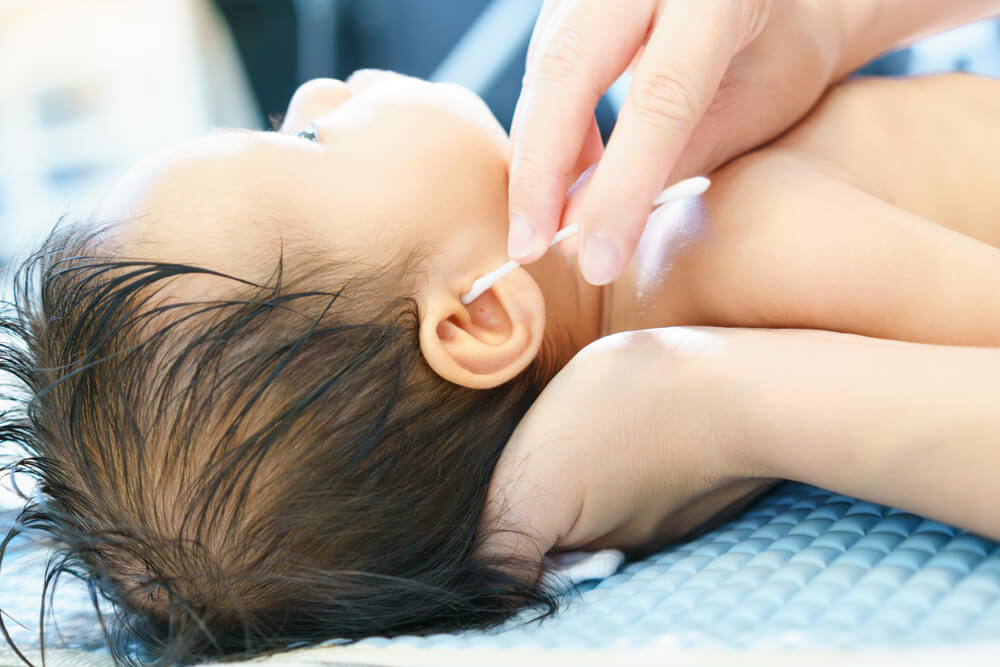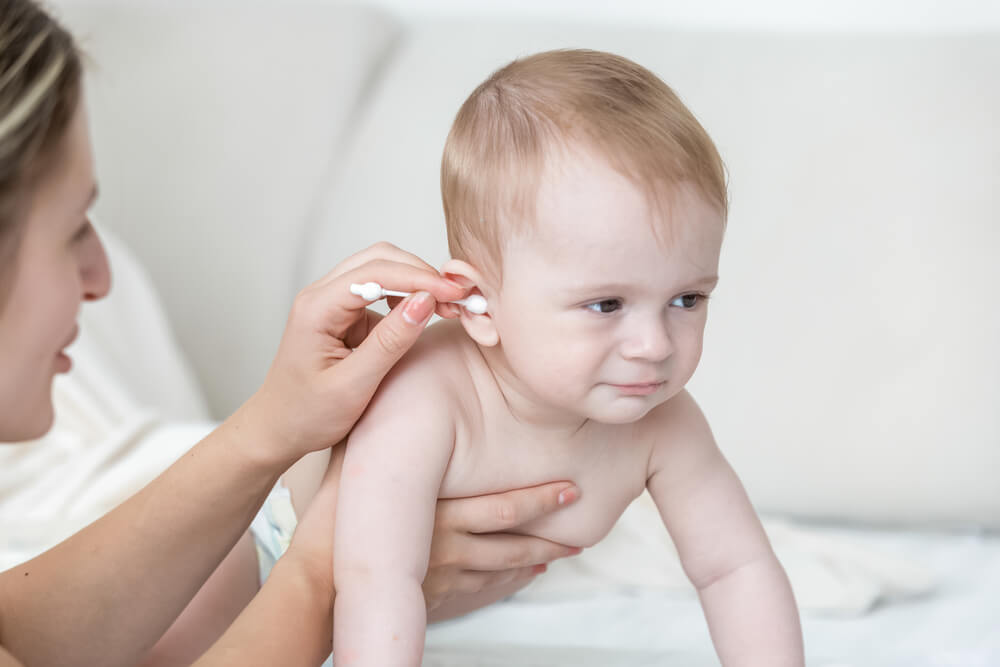Baby’s are fragile, and sometimes it can feel complicated caring for them, especially if this is your first child. Maybe you’ve gone to google and searched “ how to clean baby ears,” only to come across a million different opinions. Besides asking your pediatrician, if you’re wondering how to clean newborn ears and what to do about infant ear wax, you’ve come to the right place. Parents must be extremely careful when cleaning baby ears wax and understand the dos and don’ts.
Newborns are exceptionally delicate, and since they don’t have developed communication skills, it can be hard to tell if what you’re doing is hurting them. Nobody likes getting the insides of their ears poked, and a baby’s ear canal is highly sensitive. You need to be extremely careful when cleaning baby ears wax because you do not want to damage their eardrum. Just like adults, a baby’s ears can get clogged up with ear wax. However, how you manage your earwax is likely not the best way to take care of your infant ear wax.
What is Infant Ear Wax
Infant ear wax is almost the same as adults. The substance is sticky and yellowish. It is primarily made up of dead skin cells mixed with gluey-like texture produced by glands. Ear wax can also appear orange or brown. In adults, ear wax is a bit firmer, but infant ear wax tends to be much softer. Just like adults, infant ear wax has a natural process of evacuation. The ear wax will accumulate, dry out, and simply exit the body by falling out.
However, sometimes the natural evacuation process is not enough, and ear wax builds up. Symptoms could be visual; maybe you see earwax sticky around your child’s ear. Other symptoms can be hard to notice, like decreased hearing or irritated ears.
It can be difficult to tell if your child is experiencing pain because of earwax buildup, so the best way to decide is by looking at your child’s ears or taking your baby to the pediatrician. How to clean baby ears is not something to take lightly. Did you know that a cotton swab can make ear wax build-up even worse? It’s true! Inserting a cotton swab into the ear can actually make the ear wax compact even more.

How Much Earwax is Regular
We have earwax because it is our body’s natural defense from invasive dirt, oil, or particles entering our body. If we did not have any earwax, our ears would be sensitive to infections. Did you know our natural earwax also contains chemicals that fight off infections? This is why it is important not to go overboard on cleaning baby ears wax. Ear wax also moisturizes the ear canal. You can avoid dry, itchy ears by following the do’s and don’ts. Learning how to clean a baby’s ears properly can help their body retain its powerful defense mechanisms.
How to Clean Baby’s Ears
There are some dos and don’ts parents need to be aware of when it comes to how to clean newborn ears. A baby’s small ears can suffer harm very easily.
The Do’s and Don’ts
- Do not use a cotton swab to clean your child’s ears. When you insert a cotton swab into the ear canal, you push the majority of ear wax even deeper into the ear. Even though you may retrieve some wax on the swab, the swab likely compacted the rest. This could cause build-up and ear irritation. You can also puncture the eardrum using a cotton swab, so you should not even try it out. The irritation of a cotton swab can cause your child’s ears to bleed.
- Do not try to use your fingers to scratch out or remove ear wax. Similar to a cotton swab, a finger and nail can cause irritation. Our fingers are bigger than the cotton swab! It is not a good idea to use your fingers if you are wondering how to clean baby’s ears. Even your petite pinky finger can do some damage. Also, bacteria can build up under your fingernails, and inserting them into your child’s ear canal can introduce harmful bacteria. Your fingernails can also scratch the delicate skin or the eardrum, which is as painful as it sounds.
How To Clean Newborn Ears Correctly
Using a washcloth is the best method when it comes to how to clean baby ears. Most pediatricians recommend this method as it is the most gentle and effective. You will not cause irritation if you use this method and follow our helpful tips. When we use a washcloth, we clean the exterior of our baby’s ear and reduce the visible signs of earwax buildup. You can also use a Q-tip, but only on the exterior of the ear.
- First, grab a soft washcloth. There are many soft and child-friendly options.
- Next, submerge the washcloth in warm water. Wring out the cloth. Try holding up the cloth; if water drips down, it is too wet. Water droplets can get stuck in the baby’s ear canal, causing even more irritation and clogging.
- Be sure the temperature is not too hot. You can test the temperature by placing the towel against the inside of your wrist. If it feels too hot at all, it will be too hot for your baby. You can even first test out the temperature of the cloth by placing it against your child’s arm and seeing how they react before putting it on the sensitive ear skin. There is no need for soap on the towel.
- Next, you are ready to proceed in cleaning your baby’s ears. In a comfortable position, begin to wipe around your child’s ears. Gently work on removing crust or any build-up. Remember, do not stick the washcloth inside of the ear canal, or you risk even more clogging. You can then use a Q-tip to reach build up in the exterior ear crevices.
- Move onto the next ear, but be sure to wash the washcloth or use a fresh one before cleaning the other ear. You don’t want to spread a possible infection. Be sure to wring out your cloth as you did before.

Consider an Ear Infection
Children and babies are more at risk for ear infections because their ear canals are narrow, easily trapping, and hanging onto bacteria. You can lookout for a baby ear infection at home by noticing signs:
- Your child is constantly touching their ears.
- Your child is fussy. When it is time to fall asleep, an ear infection can be particularly irritating. If your baby is fussy before bedtime or can’t stay asleep, they could have an ear infection.
- Your child has a fever. It is important to notify the pediatrician whenever your child has a fever.
- Fluid exiting the ear.
- They do not respond to quiet sounds.
If you think your baby is suffering from an ear infection, call us today and schedule an appointment with us.



